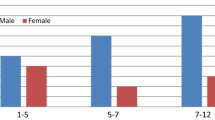Conclusions
From the present study it was concluded that Bekesy audiometry test is the most useful battery of test in diagnosis of sensori-neural deafness. The reasons are:—
-
(a)
The results are reliable and it is consistent with the results of other batteries of test.
-
(b)
Patients who are cooperative in doing other special audiological tests, can follow this simple test.
-
(c)
It shows type I and II patterns in cochlear and combined lesions and type III and IV in retrocochler lesions.
-
(d)
Single test will give an idea about hearing threshold, pattern, difference limen for the intensity and tone decay. So when a classical pattern is obtained, there is no need to go for other battery of tests, which is more time consuming.
Available literature indicated that, various patterns of Bekesy audiogram in majority of cases confine to the expected site of lesion. In minority discrepancies may occur. In such case other special tests for recruitment and tone decay are useful.
Similar content being viewed by others
References
Bekesy, G. V. (1947): A new audiometer. Acta Oto-Laryngologica. 35: 411–422.
Carhart, R. (1957): Clinical determination of abnormal auditory adaptation. Archives of Otolaryngology. 65: 32–39.
Davis, H. (1962): A functional classification of auditory defects. Annals of Otology Rhinology & Laryngology. 71: 693–704.
Harbert, F. and Young, I. M. (1964): Audiologic findings in Meniere’s syndrome. Acta Oto-Laryngologica. 57: 145–154.
Harbert, F. and Young, I.M. (1968): Clinical application of Bekesy audiometry. Laryngoscope. 78: 487–491.
Hopkinson, N.T. (1966). Modifications of the four types of Bekesy audiograms. Journal of Speech and Hearing Disorders. 31: 79–82.
Hughes, R.L., Wallace, J., Wineger, M.A., James, A. and Crabtree (1967): Bekesy audiotnetry type 2 vs type 4 patterns. Archives of Otolaryngology. 86: 424–430.
Istre, I. and Burton, M. (1969): Automatic audiometry for detecting malingering. Archives of Otolaryngology. 90: 326–332.
Jerger, J. (1960): Bekesy audiometry in analysis of auditory disorders. Journal of Speech and Hearing Research. 3: 275–287.
Jerger, J. and Herer, G. (1961): Unexpected dividend in Bekesy audiometry Journal of Speech and Hearing Disorders. 26: 390–391.
Johnson, E.W. and House, W.F. (1964): Auditory findings in 53 cases of acoustic neuromas. Archives of Otolaryngology. 80: 667–677.
Johnson, E. W. (1965): Auditory test results in 110 surgically confirmed retrocochlear lesions. Journal of Speech and Hearing Disorders. 30: 307–317.
Kacker, S. K. (1971): Need for redefining the criteria of type 2 Bekesy tracing (personal communication).
Kacker S.K. (1971) Bekesy audiometry in simulated hearing loss. Your Speech and hearing Disorders Vol XXXVI: 506–510.
Luscher. E. and Zwislocki, J. (1949): A simple method for indirect monoaural determination of recruitment phenomenon (difference limen in intensity in different types of deafness). Acta Oto-Laryngologica Stockh. Suppl. 78: 156–168.
McLay, K. (1960): Investigation of perceptive deafness by Bekesy audiometry. Journal of Laryngology and Otology. 74: 566–580.
Newby, H. A. (1964): “Audiology, Principle and Practice”. 2nd. Ed. Appleton Century Crafts Inc., New York.
Owens, E. (1964): Bekesy tracings and site of lesion. Journal of Speech and Hearing Disorders. 29: 456–468.
Owens, E. (1965): Bekesy tracings, tone decay and loudness recruitment tracing and site of lesion. Journal of Speech and Hearing Disorders. 30: 0–57.
Robertson, D.G. (1965): Use of Bekesy findings in auditory diagnosis. Journal of Speech and Hearing Disorders. 30: 367–369.
Author information
Authors and Affiliations
Rights and permissions
About this article
Cite this article
Maiya, P.S., Kacker, S.K. & Banerji, A.K. Bekesy audiometry in diagnosis of sensori-neural deafness. Ind. J. Otol. 27, 76–84 (1975). https://doi.org/10.1007/BF03047837
Received:
Issue Date:
DOI: https://doi.org/10.1007/BF03047837




